The NVIDIA GeForce GTX 650 Ti Review, Feat. Gigabyte, Zotac, & EVGA
by Ryan Smith on October 9, 2012 9:00 AM ESTPower, Temperature, & Noise
As always, we’re wrapping up our look at a video card’s stock performance with a look at power, temperature, and noise. Unlike GTX 660, GTX 650 Ti does not have GPU boost, which means the GTX 650 Ti’s load voltage is fixed at a single value. This is more important for overclocking, but because NVIDIA is not trying to min-max performance by sacrificing some power consumption, it allows the GTX 650 Ti to really turn down its power consumption. As a reminder, NVIDIA’s TDP here is 110W, with no power target (though NVIDIA throws around a “typical” number of 80W).
| GeForce GTX 650 Ti Series Voltages | |||||
| Ref GTX 650 Ti Load | EVGA GTX 650 Ti Load | Zotac GTX 650 Ti Load | Gigabyte GTX 650 Ti Load | ||
| 1.087v | 1.05v | 1.087v | 1.087v | ||
Without GPU boost voltages are quite low for desktop GeForce 600 cards. Instead of spiking at 1.175v we’re seeing a range from 1.05v to 1.087v. Meanwhile the idle voltage is typical for a GK106 card at 0.875v.
While we’re on the subject of voltages, it’s worth noting that while NVIDIA doesn’t have GPU boost active, this doesn’t mean they’ve thrown away Kepler’s power management system. Specifically there’s still a hard 1.175v ceiling, and at high voltages NVIDIA will still step down the voltage based on temperature in order to combat leakage. When overvolting our reference GTX 650 Ti we saw voltage step downs at a relatively low 56C, and another at 74C. This only applies to overvolting though, and there’s no corresponding reduction in clockspeed in any scenario.
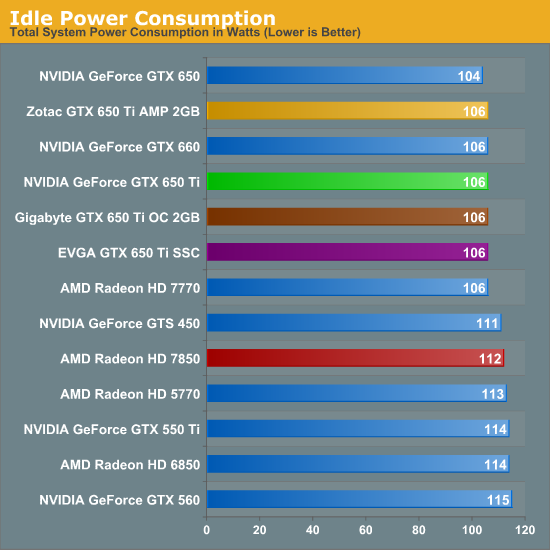
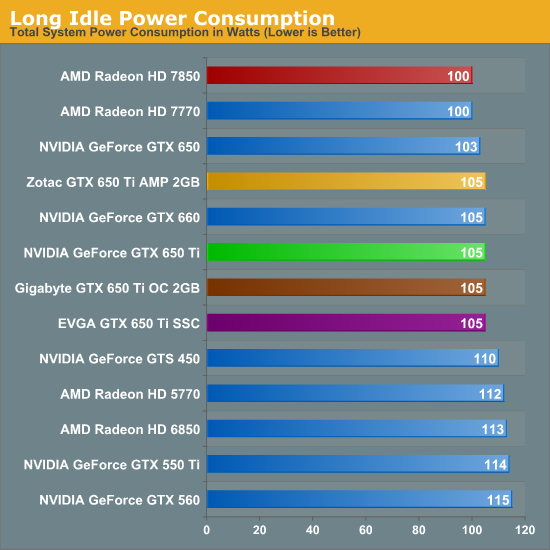
Starting as always with idle, having already seen the GK106 based GTX 660 there are no grand surprises here. Even with the disabling of some functional units the GTX 650 Ti doesn’t do any better than the full-fledged GTX 660, which is not to say that this is bad. At an NV estimated idle TDP of 5W this is still better than the 7800, and is good enough to tie the 7770. The factory overclocked cards fare no worse here either, all of which lead to our testbed hitting the same marks at the wall.
The one place NVIDIA can’t compete is in the long idle scenario with no active displays. The 7800 series still has a 5W advantage at the wall, though the benefits of something like AMD’s ZeroCore technology are not nearly as great here since the GTX 650 Ti can’t be SLI’d (and hence have a headless card).
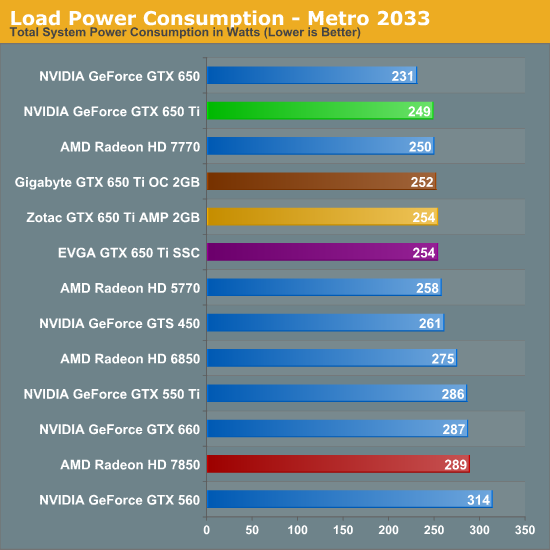
Moving on to load power consumption we’re finally seeing a test where the GTX 650 Ti has a clear architectural/design advantage over the competition. Though not strictly comparable, the 7850 has an official TDP of 150W versus 110W for the GTX 650 Ti, a difference of 40W. Meanwhile under Metro the gap between the 7850 and the GTX 650 Ti is exactly 40W (before taking into consideration PSU efficiency of course). Paper specs aside the GTX 650 Ti is clearly intended to be a lower power card than the 7850 and here it delivers. If it can’t beat the 7850 in performance then it is going to need to beat the 7850 on power consumption.
Meanwhile our factory overclocked cards present an interesting lineup. All 3 are closely clustered together in spite of the fact that the Zotac and Gigabyte cards have an extra 1GB of GDDR5 RAM to power. GDDR5 has quite the reputation for being a power hog (for a RAM), so it’s a bit surprising not to see a greater difference. The biggest driver of any power increase seems to be the overclocks themselves, leading to the marginally lower value we see for the Gigabyte card.
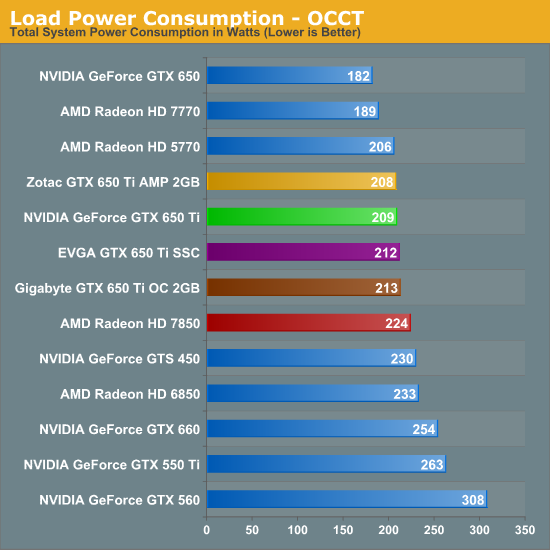
Turning to OCCT, the GTX 650 Ti doesn’t maintain the same large lead over the 7850 that it did with Metro thanks to AMD’s more aggressive throttling (and without GPU boost NVIDIA may as well not have any throttling), but reinforcing the fact that these cards are in two different power classes the GTX 650 Ti still ends up drawing less power. In fact it draws less power than the GTX 550 Ti or the GTS 450, the latter of which is not typically a high power card. Even without GPU boost – or perhaps especially without GPU boost – NVIDIA’s high power efficiency is maintained, though at a cost of rendering performance notably weaker than the immediate competition.
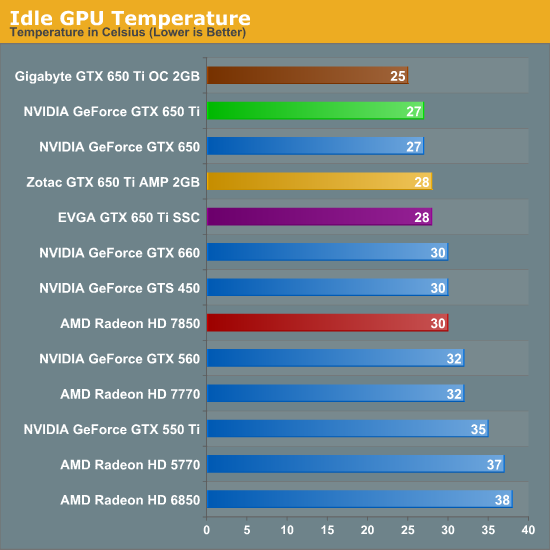
A low power GPU combined with open air coolers often leads to very low idle temperatures, and the GTX 650 Ti lives up to that tradition. It’s simply not that often that we see GPUs hit temperatures only a couple of degrees above room temperature. And in the case of Gigabyte’s card with its oversized that’s the lowest idle GPU temperature we’ve ever recorded, once more proving that there’s no kill like overkill.


Moving on to load temperatures we get to see the effectiveness of an open air cooler combined with the relatively low power consumption of the GTX 650 Ti. At 59C under Metro and 65C under OCCT our reference GTX 650 Ti holds up amazingly well, and just wait until we get to the noise readings, since this is where the GTX 650 Ti and 7850 will really stand apart. Meanwhile even with their similar designs the EVGA and Zotac cards both end up being a bit cooler, than the reference GTX 650 Ti. But the real winner is the Gigabyte card and its oversized cooler; 43C with Metro is unheard of, and 50C with OCCT is as equally impressive.

Transitioning to noise measurements we start with idle noise, where there is no great surprise as most cards have long since ceased having loud idle states. The EVGA card is a bit disappointing though, since there’s no great reason why such an open air card should be much above 41db(A).
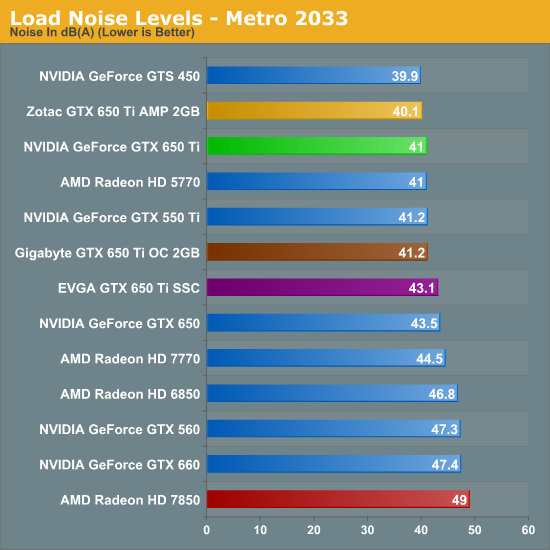
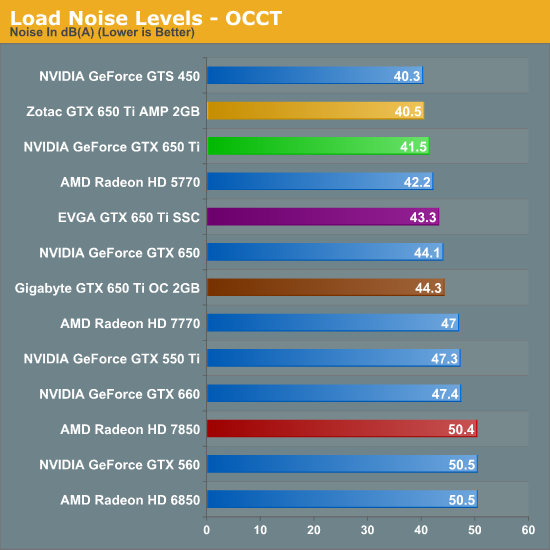
Taking a look at load noise we finally get to see the full picture. Earlier we had high praises for NVIDIA’s reference design, and this is the reason why. NVIDIA almost always hits a good balance between power, temperature, and noise, and nowhere is this more evident than with the GTX 650 Ti. Peaking at 41.5db(A) with OCCT it barely gets off of the noise floor. Meanwhile AMD’s reference 7850, complete with its blower, is almost 9dB(A) louder. Open air non-reference 7850s won’t be nearly as loud, but this is a reminder of what open air coolers can do, particularly when power consumption is low enough.
The real winner for load noise generation however is not NVIDIA’s reference design or even the Gigabyte card and its oversized cooler; it’s Zotac and their fairly plain open air cooler. Admittedly we’re looking at just a 1dB(A) difference, but if noise is crucial the Zotac card looks particularly good. Meanwhile the EVGA card, though starting out rough, doesn’t end up doing too poorly at load here. 0.3dB(A) is a tiny increase in noise over idle and it’s actually good enough to be in the middle of the pack for our retail cards.
The surprising result is the Gigabyte card, which should have the easiest time cooling. It looks like Gigabyte’s fan curve is a bit more aggressive than the rest of the GTX 650 Ti cards, which helps explain its amazingly low load temperatures, but that means there’s a noise tradeoff. Given the temperatures we’re seeing, Gigabyte was a little too aggressive with their fan curve; had they not then they could have easily swept this entire section.










91 Comments
View All Comments
flipmode - Tuesday, October 9, 2012 - link
Please, that mantra is goofy. Of course there is such a thing as a bad product. You're telling me you've never run into a product that you wouldn't buy at any price? I have. Not saying the GTX 650 Ti fits that description - it doesn't - but I just wish you'd dispense with that silly expression.Paulman - Wednesday, October 10, 2012 - link
I think it's a good saying, especially when applied to the two horse race between AMD/ATI and NVIDIA. Both companies have been executing fairly well over the past half decade or more, and ultimately the biggest factor that determines the success or value of a card is the performance vs. price. The only thing that would mess with that is a significant spat of failing parts, or ridiculously high power/noise consumption that can't be mitigated, or unfixably buggy drivers. But barring such catastrophe scenarios, if your part isn't that great by the time it hits the market, just lower the price :PCeriseCogburn - Friday, October 12, 2012 - link
It's amazing the amd fanboy brain farts spewing here.AMD lowered their frikkin 7850 price, not the card that "isn't that great that just hit the market".
I'll also point out that this nVidia card does 4 monitors out of the box, and the Asus version at the egg has a great port setup for that, and is inexpensive.
It's just amazing to me really. AMD drops in price, and the idiot response is late and slow for the card reviewed demanding a lower price.
LOL - it's so so freakin sad.
rarson - Friday, October 12, 2012 - link
You don't understand economics, do you?Homeles - Saturday, October 13, 2012 - link
"AMD lowered their frikkin 7850 price, not the card that 'isn't that great that just hit the market.'"You need to brush up on your reading comprehension skills, kid. You have completely missed the point of the post you are replying to. Quite laughably, really, especially given your condescension.
Siana - Monday, October 15, 2012 - link
OMG a sane person on the Internet!JIHAAAAD!!!!!!!!!!!!!
Uritziel - Thursday, October 11, 2012 - link
Nothing keeps a price from being negative, so the saying isn't really wrong. Bet you'd buy that bad product you have in mind for -$5000...CeriseCogburn - Friday, October 12, 2012 - link
Here, where are the amd fanboys usual bloviating load of crap spews ?I'll pretend I'm them.
This card OverClocks to 7850 speeds and passes it for $5o LESS ! you'd have to be an idiot to buy the amd card when every single nVidia 650Ti hit the same awesome overclock flying past the 7850 !
Not to mention eyefinity sucks and is dead now that 4 monitors are rockin on these 650Ti's !
I'd sure like to see amd innovate but all they care about is MONEY $$$ so they charge more!
There we go amd fanboys, FTFY, and the worse part of it all for you is it's all true instead of big fat lies like when you do it !
rarson - Friday, October 12, 2012 - link
This has nothing to do with fanboys, just like the last post didn't. We're talking about economics here, not AMD vs. Nvidia. Stop looking at everything through your green-tinted glasses and try reading what is actually on the screen. The comment you replied to has nothing to do with the cards you mentioned.Galidou - Saturday, October 13, 2012 - link
He says everyone is lying when speaking about AMD while he can hardly stay in the right path himself.... He's taking the side of the most powerful companies in the world(anything that's against AMD is worth taking their side) while spewing shit like: ''all they care about is MONEY $$$.''Let's go, take the side of the giants of this world, kill the small companies spewing shit about them so the world can turn more monopolistic than it is now... LoL funniest vomit the world had to know about... Make the rich even more rich and KILL everyone below... I have to admit AMD is in a bad situation, their CPU division fares ALOT worse than their GPU division but it's not a reason to be so stupid... so freaking imbecile..... Just so stubbornly refusing to have any respect toward anyone that doesn't TOTALLY embrace his stupid closed vision of the computer industry.
I just wish AMD gets out of there, if not then too bad, we can't change things for them. They are fighting against the giants of the computer industry that have a hundred times more budget than they do... Just for that, I'm wishing they succeed in the future.